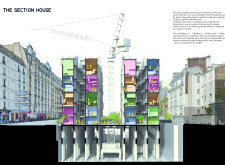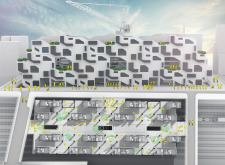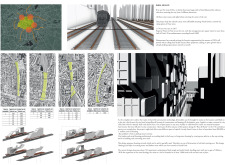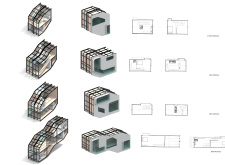5 key facts about this project
At its core, the design exemplifies a commitment to sustainability and simplicity, utilizing materials that complement the site's ecological features. The choice of materials is deliberate, combining local stone, glass, and wood to create a structure that not only echoes its natural surroundings but also withstands the test of time. The use of local stone provides a grounding element, offering durability and a tactile connection to the earth, while expansive glass facades invite ample natural light, enhancing the interior space and promoting a healthy living environment. The wood components, used in specific structural elements and finishes, add warmth to the overall design, ensuring that the atmosphere remains inviting and comfortable.
The layout of the project is carefully conceived to maximize functionality while ensuring that it nurtures social interactions among users. Open floor plans are prevalent throughout the structure, encouraging fluid movement between spaces and fostering a sense of community. This design choice is particularly relevant in today’s context where collaborative spaces are crucial for fostering communication and creativity. Furthermore, thoughtful consideration has been given to private areas, ensuring occupants can find moments of solitude when needed.
Unique design approaches differentiate this project from more conventional architectural designs. One such approach is the incorporation of biophilic design elements, which integrates natural components into the built environment. This is reflected in the extensive use of green roofs and living walls, which not only enhance the aesthetic appeal but also promote biodiversity and help regulate indoor temperatures. Additionally, the design utilizes passive solar strategies, optimizing natural light and energy efficiency, reducing reliance on artificial heating and cooling systems.
The landscape surrounding the project further enriches its purpose and aesthetic. Designed with sustainability in mind, native plant species are employed to minimize water usage and maintenance while promoting local biodiversity. Outdoor spaces serve as extensions of the interior, designed to accommodate gatherings, workshops, and recreational activities. This seamless transition between indoor and outdoor areas reinforces the project’s connection to its environment and enhances the overall user experience.
Furthermore, the architectural design itself reflects a contemporary yet timeless aesthetic, avoiding trends that may soon feel outdated. The clean lines, simple geometric forms, and an emphasis on functionality contribute to a visual language that is both modern and approachable. The design intelligently balances form and function, ensuring that the spaces created not only meet the immediate needs of their occupants but also inspire a deeper appreciation for the environment and the community.
As one explores this project, it becomes clear that attention to detail is paramount. From carefully designed architectural sections that demonstrate the relationship between various spaces to well-considered architectural plans that highlight the overall layout, every aspect of the design is about enhancing user experience while respecting natural conditions. The outcome is a project that serves as a model for future developments, marrying innovative design with a respect for the environment and community needs.
For those interested in delving deeper into the nuances of this architectural endeavor, a closer examination of the architectural plans, sections, and designs reveals the thoughtful ideation behind each element. The project not only stands as a testament to contemporary architectural practice but also invites viewers to reflect on their own relationship with the spaces they inhabit. Therefore, exploring the full project presentation offers invaluable insights into the architectural ideas that shaped this remarkable design.


























